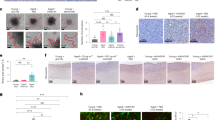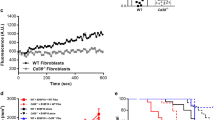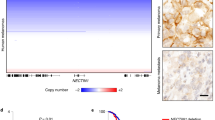Abstract
ADAM-9 is a metalloproteinase expressed in peritumoral areas by invading melanoma cells and by adjacent peritumoral stromal cells; however, its function in stromal and melanoma cells is not fully understood. To address this question in vivo in a spontaneous melanoma model, we deleted ADAM-9 in mice carrying the hepatocyte growth factor (Hgf) transgene and knock-in mutation Cdk4R24C/R24C, demonstrated to spontaneously develop melanoma. Spontaneous melanoma arose less frequently in ADAM-9-deleted mice than in controls. Similarly reduced tumor numbers (although with faster growth kinetics) were detected upon induction of melanoma with 7,12-dimethylbenz[a]anthracene (DMBA). However, more lesions were induced at early time points in the absence of ADAM-9. Increased initial and decreased late tumor numbers were paralleled by altered tumor cell proliferation, but not apoptosis or inflammation. Importantly, significantly reduced lung metastases were detected upon ADAM-9 deletion. Using in vitro assays to address this effect mechanistically, we detected reduced adhesion and transmigration of ADAM-9-silenced melanoma cells to/through the endothelium. This implies that ADAM-9 functionally and cell autonomously mediates extravasation of melanoma cells. In vitro and in vivo we demonstrated that the basement membrane (BM) component laminin β3-chain is a direct substrate of ADAM-9, thus contributing to destabilization and disruption of the BM barrier during invasion. In in vitro invasion assays using human melanoma cells and skin equivalents, depletion of ADAM-9 resulted in decreased invasion of the BM, which remained almost completely intact, as shown by continuous staining for laminin β3-chain. Importantly, supplying soluble ADAM-9 to the system reversed this effect. Taken together, our data show that melanoma derived ADAM-9 autonomously contributes to melanoma progression by modulating cell adhesion to the endothelium and altering BM integrity by proteolytically processing the laminin-β3 chain. This newly described process and ADAM-9 itself may represent potential targets for anti-tumor therapies.
This is a preview of subscription content, access via your institution
Access options
Subscribe to this journal
Receive 50 print issues and online access
$259.00 per year
only $5.18 per issue
Buy this article
- Purchase on Springer Link
- Instant access to full article PDF
Prices may be subject to local taxes which are calculated during checkout







Similar content being viewed by others
References
Edwards DR, Handsley MM, Pennington CJ . The ADAM metalloproteinases. Mol Aspects Med 2008; 29: 258–289.
Rocks N, Paulissen G, El Hour M, Quesada F, Crahay C, Gueders M et al. Emerging roles of ADAM and ADAMTS metalloproteinases in cancer. Biochimie 2008; 90: 369–379.
Weskamp G, Cai H, Brodie TA, Higashyama S, Manova K, Ludwig T et al. Mice lacking the metalloprotease-disintegrin MDC9 (ADAM9) have no evident major abnormalities during development or adult life. Mol Cell Biol 2002; 22: 1537–1544.
Parry DA, Toomes C, Bida L, Danciger M, Towns KV, McKibbin M et al. Loss of the metalloprotease ADAM9 leads to cone-rod dystrophy in humans and retinal degeneration in mice. Am J Hum Genet 2009; 84: 683–691.
Murphy G . The ADAMs: signalling scissors in the tumour microenvironment. Nat Rev Cancer 2008; 8: 929–941.
Zigrino P, Mauch C, Fox JW, Nischt R . Adam-9 expression and regulation in human skin melanoma and melanoma cell lines. Int J Cancer 2005; 116: 853–859.
Abety AN, Fox JW, Schonefuss A, Zamek J, Landsberg J, Krieg T et al. Stromal fibroblast-specific expression of ADAM-9 modulates proliferation and apoptosis in melanoma cells in vitro and in vivo. J Invest Dermatol 2012; 132: 2451–2458.
Guaiquil V, Swendeman S, Yoshida T, Chavala S, Campochiaro PA, Blobel CP . ADAM9 is involved in pathological retinal neovascularization. Mol Cell Biol 2009; 29: 2694–2703.
Felli N, Felicetti F, Lustri AM, Errico MC, Bottero L, Cannistraci A et al. miR-126&126* restored expressions play a tumor suppressor role by directly regulating ADAM9 and MMP7 in melanoma. PLoS One 2013; 8: e56824.
Landsberg J, Gaffal E, Cron M, Kohlmeyer J, Renn M, Tuting T . Autochthonous primary and metastatic melanomas in Hgf-Cdk4 R24C mice evade T-cell-mediated immune surveillance. Pigment Cell Melanoma Res 2010; 23: 649–660.
Tormo D, Ferrer A, Gaffal E, Wenzel J, Basner-Tschakarjan E, Steitz J et al. Rapid growth of invasive metastatic melanoma in carcinogen-treated hepatocyte growth factor/scatter factor-transgenic mice carrying an oncogenic CDK4 mutation. Am J Pathol 2006; 169: 665–672.
Leiter U, Meier F, Schittek B, Garbe C . The natural course of cutaneous melanoma. J Surg Oncol 2004; 86: 172–178.
Mongaret C, Alexandre J, Thomas-Schoemann A, Bermudez E, Chereau C, Nicco C et al. Tumor invasion induced by oxidative stress is dependent on membrane ADAM 9 protein and its secreted form. Int J Cancer 2011; 129: 791–798.
Sikorski EE, Hallmann R, Berg EL, Butcher EC . The Peyer's patch high endothelial receptor for lymphocytes, the mucosal vascular addressin, is induced on a murine endothelial cell line by tumor necrosis factor-alpha and IL-1. J Immunol 1993; 151: 5239–5250.
Bacac M, Stamenkovic I . Metastatic cancer cell. Annu rev pathol 2008; 3: 221–247.
Baluk P, Hashizume H, McDonald DM . Cellular abnormalities of blood vessels as targets in cancer. Curr Opin Genet Dev 2005; 15: 102–111.
Tzu J, Marinkovich MP . Bridging structure with function: structural, regulatory, and developmental role of laminins. Int J Biochem Cell Biol 2008; 40: 199–214.
Dennhofer R, Kurschat P, Zigrino P, Klose A, Bosserhoff A, van Muijen G et al. Invasion of melanoma cells into dermal connective tissue in vitro: evidence for an important role of cysteine proteases. Int J Cancer 2003; 106: 316–323.
Sotillo R, Garcia JF, Ortega S, Martin J, Dubus P, Barbacid M et al. Invasive melanoma in Cdk4-targeted mice. Proc Natl Acad Sci USA 2001; 98: 13312–13317.
Abel EL, Angel JM, Kiguchi K, DiGiovanni J . Multi-stage chemical carcinogenesis in mouse skin: fundamentals and applications. Nature Protoc 2009; 4: 1350–1362.
Xu Q, Liu X, Cai Y, Yu Y, Chen W . RNAi-mediated ADAM9 gene silencing inhibits metastasis of adenoid cystic carcinoma cells. Tumour Biol 2010; 31: 217–224.
Lin CY, Chen HJ, Huang CC, Lai LC, Lu TP, Tseng GC et al. ADAM9 promotes lung cancer metastases to brain by a plasminogen activator-based pathway. Cancer Res 2014; 74: 5229–5243.
Tao K, Qian N, Tang Y, Ti Z, Song W, Cao D et al. Increased expression of a disintegrin and metalloprotease-9 in hepatocellular carcinoma: implications for tumor progression and prognosis. Jpn J Clin Oncol 2010; 40: 645–651.
Fritzsche FR, Wassermann K, Jung M, Tolle A, Kristiansen I, Lein M et al. ADAM9 is highly expressed in renal cell cancer and is associated with tumour progression. BMC Cancer 2008; 8: 179.
Yamada D, Ohuchida K, Mizumoto K, Ohhashi S, Yu J, Egami T et al. Increased expression of ADAM 9 and ADAM 15 mRNA in pancreatic cancer. Anticancer Res 2007; 27: 793–799.
Chen CM, Hsieh YH, Hwang JM, Jan HJ, Hsieh SC, Lin SH et al. Fisetin suppresses ADAM9 expression and inhibits invasion of glioma cancer cells through increased phosphorylation of ERK1/2. Tumour Biol 2015; 36: 3407–3415.
Sarkar S, Zemp FJ, Senger D, Robbins SM, Yong VW . ADAM-9 is a novel mediator of tenascin-C-stimulated invasiveness of brain tumor-initiating cells. Neuro Oncol 2015; 17: 1095–1105.
Wan D, Shen S, Fu S, Preston B, Brandon C, He S et al. miR-203 suppresses the proliferation and metastasis of hepatocellular carcinoma by targeting oncogene ADAM9 and oncogenic long non-coding RNA HULC. Anticancer Agents Med Chem 2016; 16: 414–423.
Wang CZ, Yuan P, Li Y . MiR-126 regulated breast cancer cell invasion by targeting ADAM9. Int J Clin Exp Pathol 2015; 8: 6547–6553.
Zhang C, Zhang Y, Ding W, Lin Y, Huang Z, Luo Q . MiR-33a suppresses breast cancer cell proliferation and metastasis by targeting ADAM9 and ROS1. Protein Cell 2015; 6: 881–889.
Zigrino P, Nischt R, Mauch C . The disintegrin-like and cysteine-rich domains of ADAM-9 mediate interactions between melanoma cells and fibroblasts. J Biol Chem 2011; 286: 6801–6807.
Nath D, Slocombe PM, Webster A, Stephens PE, Docherty AJ, Murphy G . Meltrin gamma(ADAM-9) mediates cellular adhesion through alpha(6)beta(1)integrin, leading to a marked induction of fibroblast cell motility. J Cell Sci 2000; 113 (Pt 12): 2319–2328.
Mammadova-Bach E, Zigrino P, Brucker C, Bourdon C, Freund M, De Arcangelis A et al. Platelet integrin α6β1 controls lung metastasis through direct binding to cancer cell-derived ADAM9. JCI Insight 2016; 1: e88245.
Strilic B, Yang L, Albarran-Juarez J, Wachsmuth L, Han K, Muller UC et al. Tumour-cell-induced endothelial cell necroptosis via death receptor 6 promotes metastasis. Nature 2016; 536: 215–218.
Tsuruta D, Kobayashi H, Imanishi H, Sugawara K, Ishii M, Jones JC . Laminin-332-integrin interaction: a target for cancer therapy? Curr Med Chem 2008; 15: 1968–1975.
Remy L, Trespeuch C, Bachy S, Scoazec JY, Rousselle P . Matrilysin 1 influences colon carcinoma cell migration by cleavage of the laminin-5 beta3 chain. Cancer Res 2006; 66: 11228–11237.
Udayakumar TS, Chen ML, Bair EL, Von Bredow DC, Cress AE, Nagle RB et al. Membrane type-1-matrix metalloproteinase expressed by prostate carcinoma cells cleaves human laminin-5 beta3 chain and induces cell migration. Cancer Res 2003; 63: 2292–2299.
Micocci KC, de Oliveira Moritz MN, Lino RL, Fernandes LR, Lima AG, Figueiredo CC et al. Adam9 silencing inhibits breast tumor cells transmigration through blood and lymphatic endothelial cells. Biochimie 2016; 128-129: 174–182.
Fidler IJ, Nicolson GL . Organ selectivity for implantation survival and growth of B16 melanoma variant tumor lines. J Natl Cancer Inst 1976; 57: 1199–1202.
Williams RL, Courtneidge SA, Wagner EF . Embryonic lethalities and endothelial tumors in chimeric mice expressing polyoma virus middle T oncogene. Cell 1988; 52: 121–131.
McAteer MA, Schneider JE, Ali ZA, Warrick N, Bursill CA, von zur Muhlen C et al. Magnetic resonance imaging of endothelial adhesion molecules in mouse atherosclerosis using dual-targeted microparticles of iron oxide. Arterioscler Thromb Vasc Biol 2008; 28: 77–83.
Acknowledgements
We thank Prof Manuel Koch, Department of Biochemistry, University of Cologne for kindly providing the laminin β3 antibody and recombinant laminin β3-chain. We thank Jan Zamek, Claudia Coerper-Ochsman and Nina Ruers for excellent technical assistance. This work was supported by the Melanoma Research Network of the Deutsche Krebshilfe (Melanoma Verbund), by the Deutsche Forschungsgemeinschaft through the SFB829 (B4) and by Köln Fortune Program of the University of Cologne.
Author information
Authors and Affiliations
Corresponding author
Ethics declarations
Competing interests
The authors declare no conflict of interest.
Additional information
Supplementary Information accompanies this paper on the Oncogene website
Supplementary information
Rights and permissions
About this article
Cite this article
Giebeler, N., Schönefuß, A., Landsberg, J. et al. Deletion of ADAM-9 in HGF/CDK4 mice impairs melanoma development and metastasis. Oncogene 36, 5058–5067 (2017). https://doi.org/10.1038/onc.2017.162
Received:
Revised:
Accepted:
Published:
Issue Date:
DOI: https://doi.org/10.1038/onc.2017.162
This article is cited by
-
Targeting the hedgehog pathway in MET mutation cancers and its effects on cells associated with cancer development
Cell Communication and Signaling (2023)
-
Mesoporous nanodrug delivery system: a powerful tool for a new paradigm of remodeling of the tumor microenvironment
Journal of Nanobiotechnology (2023)
-
Differential roles of protease isoforms in the tumor microenvironment
Cancer and Metastasis Reviews (2019)
-
The pleiotropic roles of ADAM9 in the biology of solid tumors
Cellular and Molecular Life Sciences (2018)



